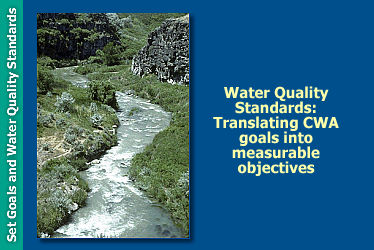
Topics in this module are
|

Topics in this module are
|
Water quality standards (WQS) are aimed at translating the broad goals of the CWA into waterbody-specific objectives. Ideally, WQS should be expressed in terms that allow quantifiable measurement. WQS, like the CWA overall, apply only to the waters of the United States. As defined in the CWA, "waters of the United States" apply only to surface waters/rivers, lakes, estuaries, coastal waters, and wetlands. Not all surface waters are legally "waters of the United States." Generally, however, those waters include the following:
The exact dividing line between "waters of the United States" according to the CWA and other waters can be hard to determine, especially with regard to smaller streams, ephemeral waterbodies, and wetlands not adjacent to other "waters of the United States." In fact, the delineation changes from time to time, as new court rulings are handed down, new regulations are issued, or the Act itself is modified.